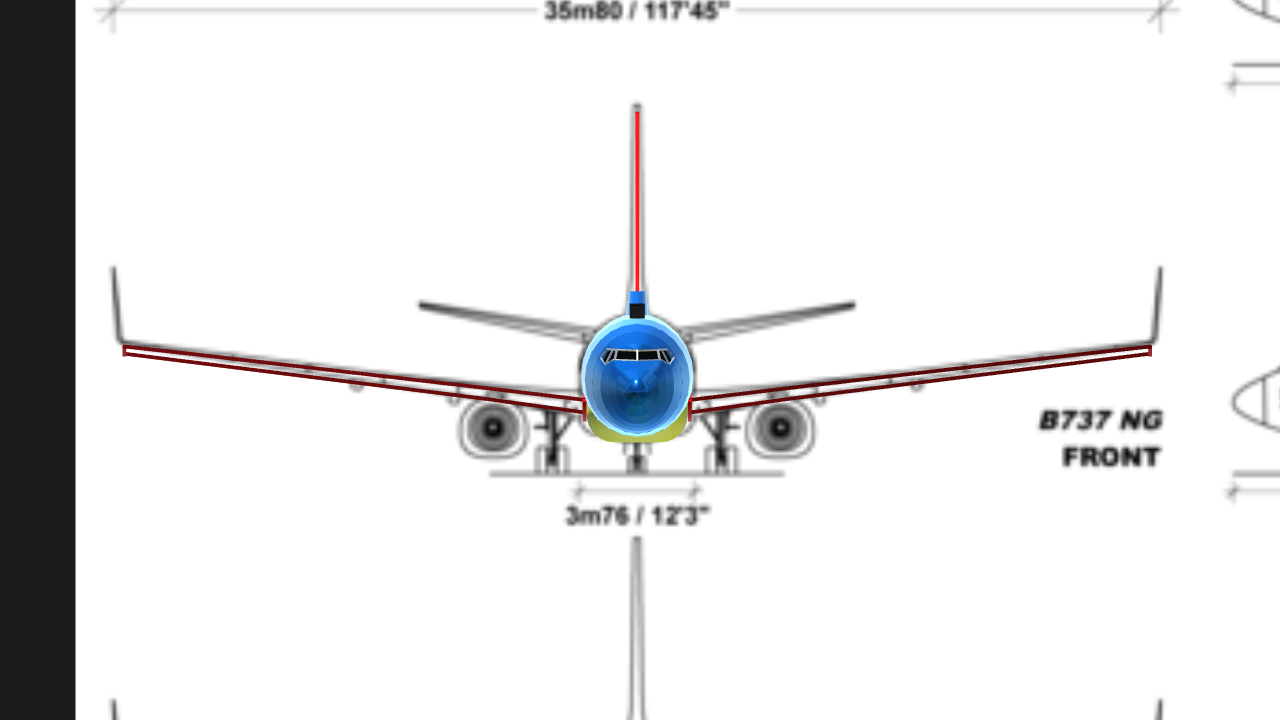I am neither trying to become a pilot nor an aviation engineer. I’m simply interested in traveling by air, and therefore I build airliners in this game. From what I have observed so far, many people’s airliner creations are pretty problematic in certain ways. So that’s why I’m writing this tutorial to show you step by step how I build an airliner.
I am talking about LARGE aircraft in general, so you may not find this helpful if you are building something else.
1. Read my previous tutorial!
The link to the nose section tutorial is in my bio. It is very useful whenever you are building hollow nose sections and struggle with the smoothness and shape.

Here is another tutorial explaining flaps and wing physics. LINK

Also, you should utilize the in-game blueprint feature by adding thin wires to match the overall shape as shown on the blueprint. It improves the accuracy of the shapes.

2. Enlarge nose section to add cockpit interior
Use fine tuner to enlarge the nose section (I would suggest 4X4X4 for length, width, and height). And you should find the process of adding interior to be very easy.


3. Reduce both drag and engine power
If you reduce both drag and engine power, you’ll find your plane capable of doing a slow gradual take-off acceleration while still be able to climb to cruise altitude and reach its conventional speed. Many people’s airliners accelerate WAY too fast.
4. In-game fuel consumption is unrealistic
Trust me, engines in this game burn fuel WAY faster than they should burn. Therefore, if you care about the environment, only place ONE real engine with power output. You can hide it at the center of the belly.
5. Custom fuel level
Because in reality, the plane would have stored full of fuel (which usually exceeds its maximum landing weight) and have a portion of it left after landing. In Simpleplanes, technically, you need to have different plane weights to simulate realistic take-off and landing physics, especially for a larger aircraft.
Therefore, I use two techniques:
You can place engines with very high XML max output that drains fuel out quickly.
Another way is that you place a big fuselage chunk capable of holding fuel, and you set its customized fuel level in the designer.
Either way, you won’t have to worry about taking off too fast or approaching too fast.


Gosh darn it. I cant bookmark it :/
Very nice.
@asteroidbook345 exactly
Sometime soon, I’m in lockdown till the 29th, so probably before then. ChiChiWerx is helping with the flight model so once that’s done I’ll be able to finish detailing @QingyuZhou
@asteroidbook345 damn, parts count eater
@QingyuZhou insert monkey puppet here
I'm working on my Super-Mystère B.2 since maybe 1-2 years...
When are you gonna post the F-4? You haven't posted any planes for like a year XD
I will probably tweak on some other planes before finishing that 737. But really idk, the upcoming college life for me is gonna be busy
@CRJ900Pilot
Nice! I’m still working on my F-4 and a Scaled Composites Model 133. Would you like to finish that 737 soon? @QingyuZhou
Are those hinge rotors?
@CRJ900Pilot yeah, also I'm thinking of building something recently
Very useful, thanks for tagging me!
need stronger pistons and hinges.
especially for hearvy, large aircraft
Yeah I didn’t realize problems with drag in my earlier builds either. But my latest Il-62 has very realistic flight physics. @jamesPLANESii
Number 2 can be applied to everything. It is super useful!
And number 3 is probably the most common mistake I see on this site. People don’t bother adjusting the drag and give the plane heaps of power instead and the planes end up being able to takeoff shorter than a Cessna and climb vertical at cruising speed.
@Sinacraft
@1918
@CRJ900Pilot
@asteroidbook345
@Vidal99977
@Marine